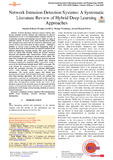Network Intrusion Detection Systems: A Systematic Literature Review of Hybrid Deep Learning Approaches

View/
Date
2022-06Author
Wanjau, Stephen K.
Wambugu, Geoffrey M
Oirere, Aaron M.
Metadata
Show full item recordAbstract
Network Intrusion Detection Systems (NIDSs) have become standard security solutions that endeavours to discover unauthorized access to an organizational computer network by scrutinizing incoming and outgoing network traffic for signs of malicious activity. In recent years, deep learning based NIDSs have emerged as an active area of research in cybersecurity and several surveys have been done on these systems. Although a plethora of surveys exists covering this burgeoning body of research, there lacks in the literature an empirical analysis of the different hybrid deep learning models. This paper presents a review of hybrid deep learning models for network intrusion detection and pinpoints their characteristics which researchers and practitioners are exploiting to develop modern NIDSs. The paper first elucidates the concept of network intrusion detection systems. Secondly, the taxonomy of hybrid deep learning techniques employed in designing NIDSs is presented. Lastly, a survey of the hybrid deep learning based NIDS is presented. The study adopted the systematic literature review methodology, a formal and systematic procedure by conducting bibliographic review, while defining explicit protocols for obtaining information. The survey results suggest that hybrid deep learning-based models yield desirable performance compared to other deep learning algorithms. The results also indicate that optimization, empirical risk minimization and model complexity control are the most important characteristics in the design of hybrid deep learning-based models. Lastly, key issues in the literature exposed in the research survey are discussed and then propose several potential future directions for researchers and practitioners in the design of deep learning methods for network intrusion detection
Collections
- Journal Articles (CI) [143]
